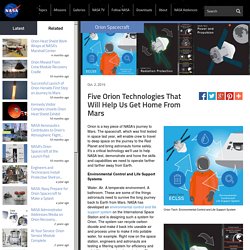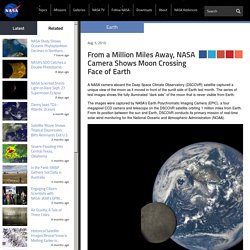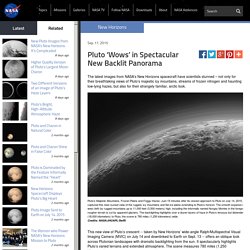

Satellite imagery from Mars reveals an unexpected feature: blue splotches >> Studying a comet’s ion tail may explain solar wind variability & high temps @NASASunEarth. China Put a Telescope on the Moon in 2013, Astronomers Reveal. Dark area of the sun is a coronal hole where magnetic field is open to space @NASASunEarth. An out of this world selfie of @MarsCuriosity lets us see the state of the rover’s hardware. Impact craters seen during @NASANewHorizons #PlutoFlyby can tell us about Pluto's history. 12 Amazing Photos That Will Make You Feel So Very Insignificant. 2015 - 10 - Nalla, the persuader. An ancient stream carried pebbles on Mars for several miles, according to new data >>
Rocket Spaceflight Accurately Described by Scottish-Canadian Scientist in 1861. By Henry Stewart Author and space historian Robert Godwin has released a paper claiming primacy for Ontario in the historical space race.

His research credits the fifth principal of Queens University in Ontario, Presbyterian minister William Leitch (1814-1864), with being the first trained scientist to have applied scientific principles to accurately describe the rocket as the best device for travelling in space. Jupiter in 4k Ultra HD. Mimas and Pandora both orbit Saturn, but they are very different moons. More @CassiniSaturn. International Space Station Tour 2012 (HD) ISS Tour. @astro_timpeake Hey AstroMan ! A message from me to wish you Bon Voyage ! Rock ! Bri. Astronauts Playing With Floating Water Blobs is the Most Mesmerizing Thing You’ll See Today. Here on Earth, the sight of an effervescent tablet being added to water is nothing special.

In microgravity, however, the small chemical reaction is a spectacle, as evidenced by new footage from the International Space Station: The newly released video is so mesmerizing thanks in part to the Epic Dragon, the advanced 4K camera used to shoot it. First delivered to the ISS earlier this year, Epic Dragon is capable of shooting with six times more detail than other cameras aboard the space station. "The cameras are being evaluated for capturing science data and vehicle operations," the agency explains in a news release. "The higher resolution images and higher frame rate videos can reveal more information when used on science investigations, giving researchers a valuable new tool aboard the space station. " Although you'll need a special monitor to get the full 4K experience, the high-definition footage still looks pretty remarkable on a standard screen.
Now that @NASANewHorizons detected water ice on Pluto, we need to find out why it exists there. Hashtag #yearinspace sur Twitter. The first space suit. I bet it pinched. (made for Wiley Posts's 1935 high altitude flights by BF Goodrich) NASA: What We Have To Do To Get to Mars. NASA outlined the many challenges that remain before humans can set foot on Mars, calling the problems “solvable” but setting no firm date for an astronaut mission to the Red Planet.

Updated details of the space agency’s Mars strategy were contained in a 36-page document released to the public ahead of upcoming talks with Congress about budgets for space exploration and a major international meeting of the space industry to be held in Jerusalem next week. The United States is “closer to sending American astronauts to Mars than at any point in our history,” said NASA administrator Charles Bolden. Photos: Real NASA Space Tech in ‘The Martian’ “In the coming weeks, I look forward to continuing to discuss the details of our plan with members of Congress, as well as our commercial and our international partners, many of whom will be attending the International Astronautical Congress next week,” he said in a statement. The forests and running trails of Star City miss you, @astro_kjell! Cool crisp Autumn air & vibrant colors are here! We're releasing a collection of new images from our @ChandraXray archive. More #NASABeyond.
Untitled. Pick-up Styx! New @NASANewHorizons image reveals size & shape of Pluto’s smallest moon, Styx. An aging star in this planetary nebula waves goodbye in its final stages of life @NASA_Hubble. Mars' Gale Crater was once a huge lake, according to data from the Curiosity rover >> A bit of retouching magic makes NASA's Apollo photos even more breathtaking >> New Horizons Finds Blue Skies and Water Ice on Pluto. The newest high-resolution images of Pluto from NASA’s New Horizons are both dazzling and mystifying, revealing a multitude of previously unseen topographic and compositional details.

The image below -- showing an area near the line that separates day from night -- captures a vast rippling landscape of strange, aligned linear ridges that has astonished New Horizons team members. “It’s a unique and perplexing landscape stretching over hundreds of miles,” said William McKinnon, New Horizons Geology, Geophysics and Imaging (GGI) team deputy lead from Washington University in St. Louis. “It looks more like tree bark or dragon scales than geology. Instagram. A Swirling Storm From Space By Nasa.
Houston, We Have Liftoff! Reading btwn the…sand dunes. Images of Martian dunes reveal info on fractured ground beneath. Our orbiter views real regions on Mars where #TheMartian movie places future missions @HiRISE. Meet Nix & Hydra, two tiny moons of Pluto observed during @NASANewHorizons July #PlutoFlyby. Thousands of Original Apollo Mission Photographs Make their Way to Flickr. Learn more about the Apollo missions: If your space-loving friends disappear for the next few days, it's a safe bet that they're losing themselves in the thousands of original Apollo mission photos that have been uploaded to Flickr over the past few days.

Many of the photos have been seen before in some form or another, but this is the first time that the unprocessed, high-resolution version of NASA's most iconic lunar mission photography has been presented in one exhaustive collection. Kipp Teague, a Virginia-based NASA enthusiast who spearheaded the project, originally started curating NASA's content in 1999, when he launched the Project Apollo Archive. The website serves "as an online reference source and repository of digital images pertaining to the historic manned lunar landing program. " Teague's website, however, featured NASA-processed versions of the mission photographs, which were color-corrected and adjusted for brightness. Thousands of original Apollo photographs are now available online >> #OTD 1984, the history-making STS-41G space shuttle mission launched. Details @NASAHistory.
Five Orion Technologies That Will Help Us Get Home From Mars. The United Launch Alliance Delta IV Heavy rocket, with NASA's Orion spacecraft mounted atop, lifts off from Cape Canaveral Air Force Station's Space Launch Complex 37 at at 7:05 a.m.

EST, Friday, Dec. 5. Credits: NASA/Bill Ingalls By Steven Siceloff,NASA's Kennedy Space Center, Fla. The United Launch Alliance Delta IV Heavy rocket, with NASA's Orion spacecraft sealed at the top, is brilliantly lit at Space Launch Complex 37 shortly before liftoff. Greetings from Mars! Here's what's up in the foothills of Mount Sharp #JourneyToMars. Life on Mars: Scientists find evidence of water flowing on Mars, in 12 pictures!! Check this. Tour Weird Ceres: Bright Spots and a Pyramid-Shaped Mountain. This sleek igloo just won NASA's 3-D Printed Mars Habitat contest >> Photos of water on Mars. For years, a team of NASA scientists had pondered over the enigmatic dark streaks lining the inner and outer faces of craters on the Martian surface, shown below.

But no longer. NASA announced the answer to the conundrum Monday: The streaks are evidence of flowing water. NASA/JPL-Caltech/Univ. of Arizona Most mysterious about these streaks — which can be as long as a football field — was that they appeared to change in size over time, growing longer during Mars' warm summer months and shrinking during colder seasons: If these photos were taken on Earth, the immediate conclusion would be flowing water. All that changed Monday when the NASA team announced that these dark, mysterious features were, indeed, flowing water. There are many pieces that had to fit together to finally conclude, beyond a doubt, that this was water and not a bizarre pattern from Martian weather. Day 188. #Sunset came, and #Progress followed. #GoodNight from @space_station! #YearInSpace. New close-up views of Pluto’s moon Charon show a colorful & violent history #PlutoFlyby. Russian Progress cargo ship is safely in orbit. Docking at 6:54pm ET. Watch live at 6:15pm.
#Progress lights up the night sky, as seen from @space_station! #YearInSpace. It's not one comet, it's two! The gravity vectors gave it away. Mid-level solar flare spotted! It's the bright flash in the lower right side @NASASunEarth. Happy #NationalCoffeeDay from @space_station! #YearInSpace. Mt. Olympus, #Mars. Fear The Aliens.
What is the green flash you can see as the Sun sets? This image shows dark streaks from flow of briny liquid water on Mars #MarsAnnouncement. . @NASA announces that under certain circumstances liquid water has been found on Mars #MarsAnnouncement. .@Astro_Kimiya releases #HTV5 with @CSA_ASC robotic arm at 12:53pm ET/4:53pm UTC... LIVE NOW: Major Mars mystery revealed! Watch live on NASA TV & use #askNASA for questions. NASA's major announcement: Liquid water has been spotted in these Martian hills. The mystery is solved: water flows on #Mars. Learn more >> Relive our favorite Martian mysteries and revelations from 2015 so far >> A coronal mass ejection on 31 August 2012 @NASA.
ThatsEarth: On this day, 45 years ago, ... A storm on the Sun, imaged by the SOHO spacecraft. Solar outbursts can affect us on Earth. Day 183- Six months in space #saturdayselfie and a #GoodNight from @SpaceStation! #YearInSpace. @NASA's announcing a "major Mars science finding" on Monday. I'm very curious what it will be. Fly through the exploded remains of a dead star. A solar eruption on 28 October 2003 @NASA. The best places to see the rare #SuperBloodMoon this weekend. The best places to see the rare #SuperBloodMoon this weekend. This Real Scale Model Of Our Solar System Built On An Open Desert Will Surprise You. Our Favorite Martian Mysteries & Discoveries of 2015. NASA is set to announce a 'major science finding' regarding its exploration of Mars on Monday morning.

Your guess is as good as ours as to what the agency may reveal during this much-hyped event, but it sounds like it's going to be quite the game-changer. Already, though, 2015 has had its fair share of amazing Red Planet mysteries and revelations. While NASA stays tight-lipped for the next few days, relive some of our favorite Mars moments from this year: This latest Mars oddity was spotted by members of the UnmannedSpaceflight.com forum in an image captured by Curiosity's Mastcam on sol 1089 of the mission (Aug. 30). Once you spot it, it becomes obvious; it really does look like a spoon hanging in the air, just above the surface of some layered rock.
From blue splotches to floating spoons, check out our favorite Mars moments from this year >> A mountain of ice goes 4-wheeling across Pluto. Exploration stretches our understanding. Extreme space weather could trigger global blackouts lasting up to a year. Orbiting all alone out in space. Two of Saturn's moons are almost hidden in the rings in this image from @CassiniSaturn. Earth’s gravitational pull is reshaping the surface of the moon.
From a Million Miles: The Moon Crossing the Face of Earth. Bill (was 02L/91L) - Gulf of Mexico This animation of images captured June 20 to 22 from NOAA's GOES-East satellite shows Tropical Depression Bill's remnants moving through the Ohio Valley and moving off the northeastern U.S.

Credits: NASA/NOAA GOES Project The remnants of Tropical Depression Bill soaked a large part of the U.S. from Texas to Washington, D.C. before moving into the Atlantic Ocean. NOAA's GOES-East satellite captured the movement over several days. An animation of images captured June 20 to 22 from NOAA's GOES-East satellite was created by the NASA/NOAA GOES Project at NASA's Goddard Space Flight Center, Greenbelt, Maryland. The National Weather Service Weather Prediction Center in College Park, Maryland provided the following list of total rainfall in selected cities as of 2 a.m.
Rob Gutro NASA's Goddard Space Flight Center June 19, 2015 - NASA Sees Tropical Depression Bill Tracking Through U.S. Bill Still a Tropical Depression At 11 a.m. Images. NASA — Solar System: 10 Things to Know This Week. "Teach them to long for the endless immensity of the sea." ~Saint Exupéry #JourneyToMars @NASA. NASA sur Twitter : "First time the Earth & the moon blocked our sun observing spacecraft's view at the same time: Art Meets Science in New Pluto Aerial Tour. NASA sur Twitter : "A merger made among the stars! Pair of galaxies collided ~700 million years ago: @NASA_Hubble.
Catherine Q. sur Twitter : "Including this beauty of Comet Jacques passing in front of the Heart Nebula. Wow. Scott Kelly sur Twitter : "Day 174. Look at these #stars. Good night from @space_station! #YearInSpace... NASA sur Twitter : "Join @WhiteHouse in sending well-wishes to @StationCDRKelly halfway through his #YearInSpace: Pluto ‘Wows’ in Spectacular New Backlit Panorama. NASA scientist Nikolaos Paschalidis, who recreated five instrument-enabling microchips for one of the instruments flying on the New Horizons mission, has waited nearly 10 years for the mission to reach its destination.

Credits: NASA Goddard/Bill Hrybyk Artist’s concept of the New Horizons spacecraft as it approaches Pluto and its largest moon, Charon, in July 2015. The craft's miniature cameras, radio science experiment, ultraviolet and infrared spectrometers and space plasma experiments will characterize the global geology and geomorphology of Pluto and Charon, map their surface compositions and temperatures, and examine Pluto's atmosphere in detail. The spacecraft's most prominent design feature is a nearly 7-foot (2.1-meter) dish antenna, through which it will communicate with Earth from as far as 4.7 billion miles (7.5 billion kilometers) away.
NASA sur Twitter : "Wow! New views of Pluto’s foggy hazes, icy plains & mountains: #PlutoFlyby @NASANewHorizons. Life on Earth sur Twitter : "The planets aligned... Twitter Video. Chris Hadfield on Twitter: "This moon of Saturn is covered by a saltwater ocean, spewing geysers through its icy crust. Intl. Space Station on Twitter: ".@StationCDRKelly is at the halfway point of his #YearInSpace, pushing the limits to learn how to survive in space. NASA 3D-Printed Habitat Challenge. Kelly Redmond sur Twitter : "Milky Way, taken from my garden last night @barrabest @BBCEarth @AwesomeAstroPod @CanonUKandIE @VirtualAstro @fcain. NASA sur Twitter : "Peering from shadows, @CassiniSaturn spacecraft sees night side of Saturn & its moon Tethys: Untitled. NASA sur Twitter : "Smoke goes around the world. Alaska & Canada wildfires could impact larger area: @NASANPP. Beautiful Pictures sur Twitter : "Earth, Jupiter, and Venus from the surface of Mars.